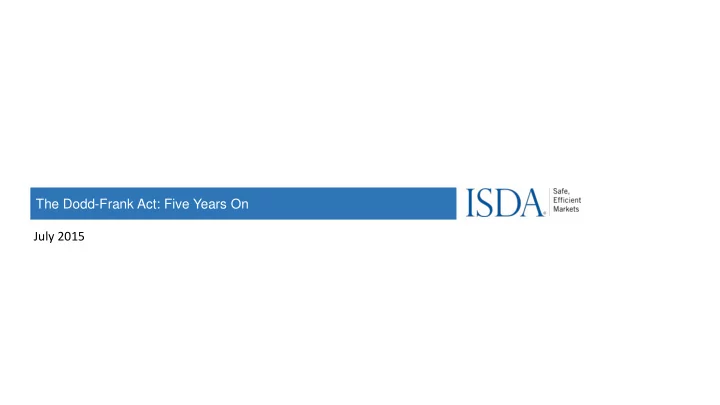

The Dodd-Frank Act: Five Years On July 2015
Title VII Progress • Clearing of standardized derivatives products • Trading of mandated derivatives products on a regulated exchange or swap execution facility (SEF) • All swap transactions required by the CFTC to be reported a swap data repository (SDR) • Regulation of swap dealers (SDs) and major swap participants (MSPs) – Margin for non-cleared derivatives – Implementation of capital rules The Dodd-Frank Act: Five Years On
Clearing CDS index average daily notional volume: IRD average daily notional volume: total, cleared, non-cleared total, cleared, non-cleared (US$ billions) (US$ billions) 700 40 35 600 30 500 25 400 20 300 15 200 10 100 5 0 0 Q12013 Q22013 Q32013 Q42013 Q12014 Q22014 Q32014 Q42014 Q12015 Q22015 Q12013 Q22013 Q32013 Q42013 Q12014 Q22014 Q32014 Q42014 Q12015 Q22015 Cleared Non-Cleared Total Cleared Non-Cleared Total During the first half of 2015, 78% of average daily CDS index During the first half of 2015, 75% of average daily interest rate derivatives notional volume was cleared notional volume was cleared Source: ISDA SwapsInfo data (DTCC/Bloomberg SDRs) The Dodd-Frank Act: Five Years On
Trade Execution IRD average daily notional volume: CDS index average daily notional volume: total, SEF, bilateral total, SEF, bilateral (US$ billions) (US$ billions) 700 40 35 600 30 500 25 400 20 300 15 200 10 100 5 0 0 Q12014 Q22014 Q32014 Q42014 Q12015 Q22015 Q42013 Q12014 Q22014 Q32014 Q42014 Q12015 Q22015 SEF Bilateral Total SEF Bilateral Total During the first six months of 2015, 69% of average daily CDS During the first six months of 2015, 55% of average daily interest index notional volume was traded on a SEF rate derivatives notional volume was traded on a SEF Source: ISDA SwapsInfo data (DTCC/Bloomberg SDRs) The Dodd-Frank Act: Five Years On
Cross-border Harmonization The European market for euro IRS: percentage of market share Source: LCH.Clearnet The Dodd-Frank Act: Five Years On
Title VII – Areas of Focus Issue To be Addressed Reporting Regulators are unable to gain a clear picture of global risk exposures and possible concentrations because of differences in reporting requirements within and across borders. Regulators across the globe need to identify and agree on the trade data they need to fulfill their supervisory responsibilities, and then issue consistent reporting requirements. The Dodd-Frank SDR indemnification requirements should be repealed to foster greater cross-border sharing of data. Further work is also needed by the industry and regulators to develop and then adopt standardized product and transaction identifiers, as well as reporting formats. ISDA has played a leading role in this area through its taxonomies, FpML reporting standard and unique trade identifier prefix service (UTIPrefix.org), among other things. Trade Execution Targeted amendments of US SEF rules – for instance, allowing greater flexibility in execution methods in certain cases – would encourage more trading on these venues and help facilitate cross-border harmonization. Further refinements, including to the MAT determinations process (the CFTC should make the final decision following a short public consultation, and a new mechanism should be introduced to allow a SEF or SEF user to petition for the removal of a MAT determination if liquidity conditions changes) and block trade rules (removal of the requirement for block trades to be executed away from SEFs), would also help eliminate incongruities. Clearing Central counterparties have become systemically important. More work is needed to ensure they are resilient – for example, through greater transparency on margin methodologies and minimum standards for stress tests. Further regulatory input is also required on acceptable recovery tools and the conditions for resolution that do not involve use of public money. The Dodd-Frank Act: Five Years On
Title VII – Areas of Focus Issue To be Addressed Margin Finalizing the non-cleared derivatives margin rules swiftly is important in order to maximize the time for preparation. ISDA has been leading industry implementation efforts – for example, through the development of the ISDA Standard Initial Margin Model (ISDA SIMM), a common calculation engine for computing initial margin requirements, which will reduce the potential for disputes. But certainty in the rules is required in order to progress this effort. Achieving global consistency in the rule sets is also imperative. For example, proposals from US prudential regulators would subject transactions between affiliates of the same financial group to margin requirements, putting financial institutions operating in the US at a competitive disadvantage internationally. Capital Capital rules should be globally consistent to prevent financial institutions and non-financial corporates in one jurisdiction being put at a competitive disadvantage. Regulation should be coherent and appropriate to the risk of a given activity. The interplay of the various regulatory components should be comprehensively assessed to ensure the cumulative impact is fully understood to avoid excessively high financing costs for borrowers and increased hedging costs for end users. Regulation of SDs Despite the requirement to register with the CFTC as SDs or MSPs from December 31, 2012, all firms remain and MSPs provisionally registered. Likewise, all SEF and SDR registrations are provisional. Final registration is needed so these firms can put an end to regulatory doubt. The Dodd-Frank Act: Five Years On
Recommend
More recommend